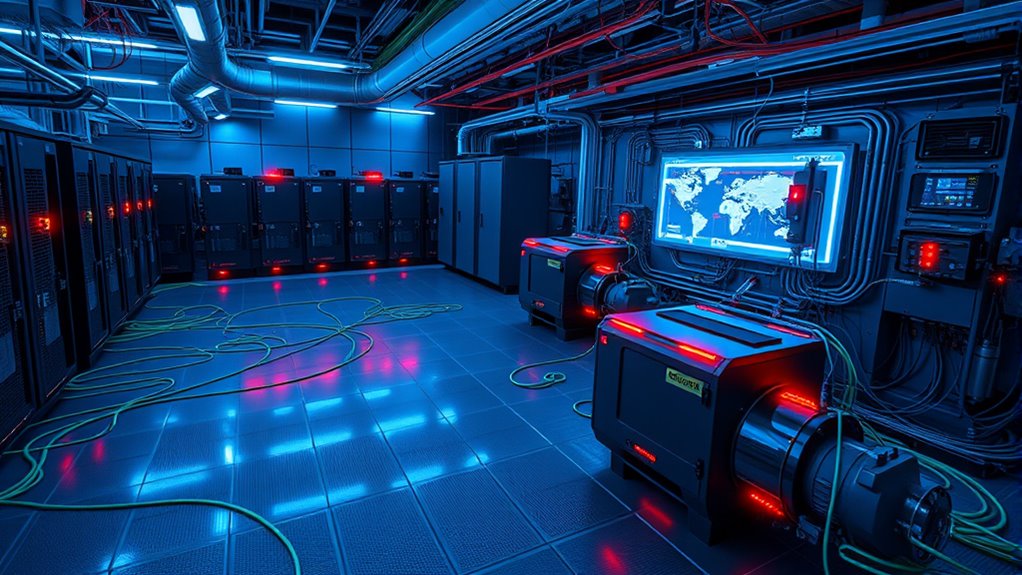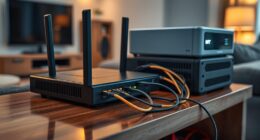To map essential circuits for backup power, start by identifying critical appliances like refrigerators, medical devices, and communication systems. Check your main electrical panel and label each breaker’s function. Classify circuits by priority—life safety, comfort, or convenience—and focus on those necessary during outages. Plan your backup system around these essentials, ensuring safety and compliance. If you want detailed steps to optimize your setup, keep exploring the key considerations involved.
Key Takeaways
- Identify critical appliances and circuits by reviewing the main electrical panel and appliance manuals for wattage and function.
- Label each breaker and circuit to distinguish essential loads such as medical devices, refrigeration, and communication systems.
- Categorize circuits into priority levels (life safety, comfort, security) to determine backup importance.
- Map out the wiring layout of essential circuits for clear identification during system design and troubleshooting.
- Create a visual diagram linking critical loads to their breakers to facilitate efficient backup power planning and implementation.
Assessing Your Home’s Critical Needs
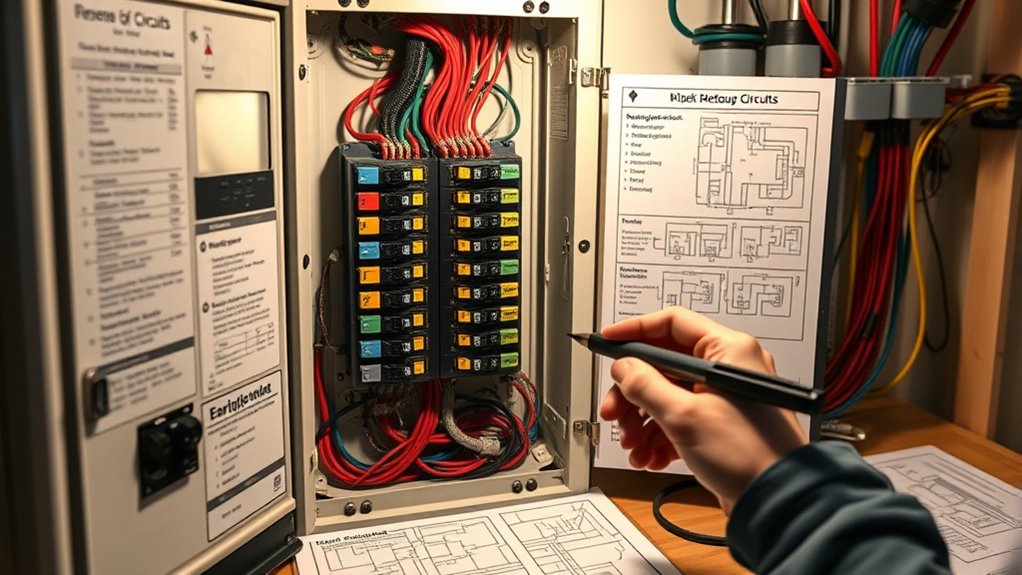
To effectively plan your backup power system, you need to clearly identify your home’s critical needs. Start by estimating how much energy your essential appliances consume and how long you’ll need backup power during outages. Calculate watt-hours for each device by multiplying its wattage by the estimated outage duration, then convert total watt-hours into kilowatt-hours for battery sizing. Consider regional outage patterns and seasonal variations, like winter heating or summer cooling, which may extend backup needs. Prioritize appliances that ensure safety and basic comfort, such as refrigeration, medical devices, heating or cooling systems, communication devices, and water pumps. Understanding your regional outage frequency can help you better plan for longer or more frequent outages. Additionally, reviewing your existing electrical setup and wiring basics can help identify potential system improvements or safety considerations. Incorporating energy efficiency measures can further optimize your backup system, reducing overall capacity requirements. Implementing space-saving solutions can also facilitate easier installation of backup components in confined areas. This focused approach helps you determine the right size and type of backup system to maintain your home’s critical functions during extended power interruptions.
Identifying Essential Circuits and Loads
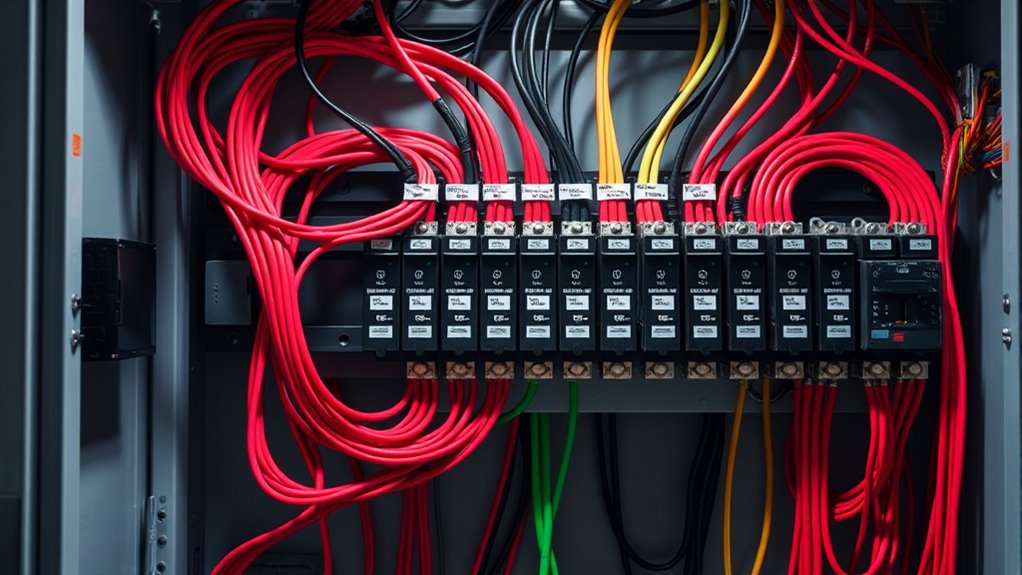
Identifying your home’s critical circuits and loads begins with reviewing the main electrical panel and clearly labeling each breaker’s function. Focus on circuits crucial for safety, comfort, and security, such as refrigeration, HVAC, medical devices, lighting, and security systems. Check appliance manuals or labels for wattage and electrical needs, accounting for both running and surge wattage, especially for motor-driven appliances. This helps determine your backup power capacity. Use the table below to categorize essential loads:
| Circuit Type | Examples | Priority Level |
|---|---|---|
| Life Safety Devices | Smoke alarms, medical devices | High |
| Comfort & Safety | HVAC, lighting | Medium |
| Security Systems | Alarms, cameras | High |
| Convenience Loads | Kitchen outlets, laundry | Low |
Creating a Backup Power Priority List
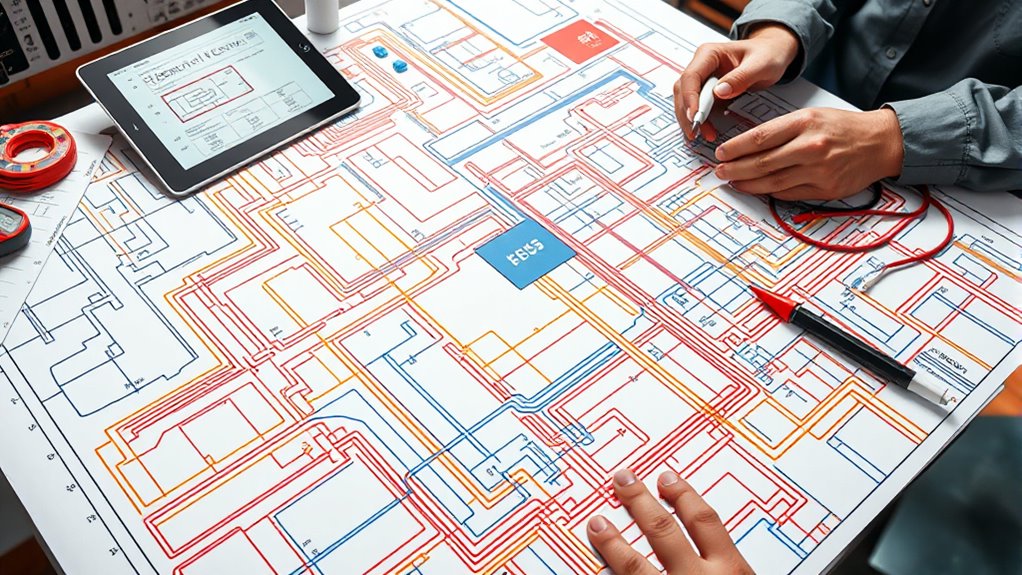
Creating a backup power priority list begins with evaluating which areas or equipment cause the most disruption during outages. You need to identify circuits that support critical functions such as refrigeration, communications, and safety systems. Focus on loads that ensure business continuity and include life-support or essential medical devices as top priorities, following emergency power guidelines. Assess the electrical load characteristics to prevent overloading backup sources and optimize load management. Calculate expected runtime based on battery capacity and prioritized loads, excluding oversized equipment that could drain batteries quickly. Balance the load to extend backup duration and confirm the system supports the necessary voltage and phases. Regularly review and adjust your priority list as loads or system capacity change to maintain reliability during outages. Understanding Backup Priorities is essential for effective load management and ensuring critical systems are maintained during power outages. Additionally, considering the benefits of efficient heating can help in planning backup systems that support essential comfort and safety features during extended outages. Incorporating load-shedding strategies can further improve backup system performance by eliminating non-essential loads during outages, which aligns with smart marketing strategies that emphasize data-driven decision making and optimization.
Designing the Essential Circuit Panel

Designing the essential circuit panel involves selecting components that can safely handle your critical loads and guaranteeing the panel is properly rated for the total electrical demand. You need to choose a panelboard with an ampere rating that matches or exceeds your load requirements, typically between 100A and 200A for residential systems. Circuit breakers must be correctly rated to protect each circuit and sized according to conductor ampacity. Use high-quality components like busbars, terminal blocks, and grounding bars that meet system ratings for reliability. Guarantee the enclosure is suitable for environmental conditions and provides adequate heat dissipation. Proper labeling, adherence to NEC and UL standards, and clear schematic documentation are vital for safety, compliance, and ease of future troubleshooting. Ensuring that the panel design incorporates system ratings helps maintain overall safety and efficiency of your backup power setup. Additionally, verifying that the panel is compatible with load calculations ensures the system can handle future expansions or modifications safely. Incorporating protective devices into your design further enhances safety by preventing overloads and faults. It is also essential to consider support from manufacturers to ensure compatibility and access to technical assistance when needed.
Wiring and Safety Considerations
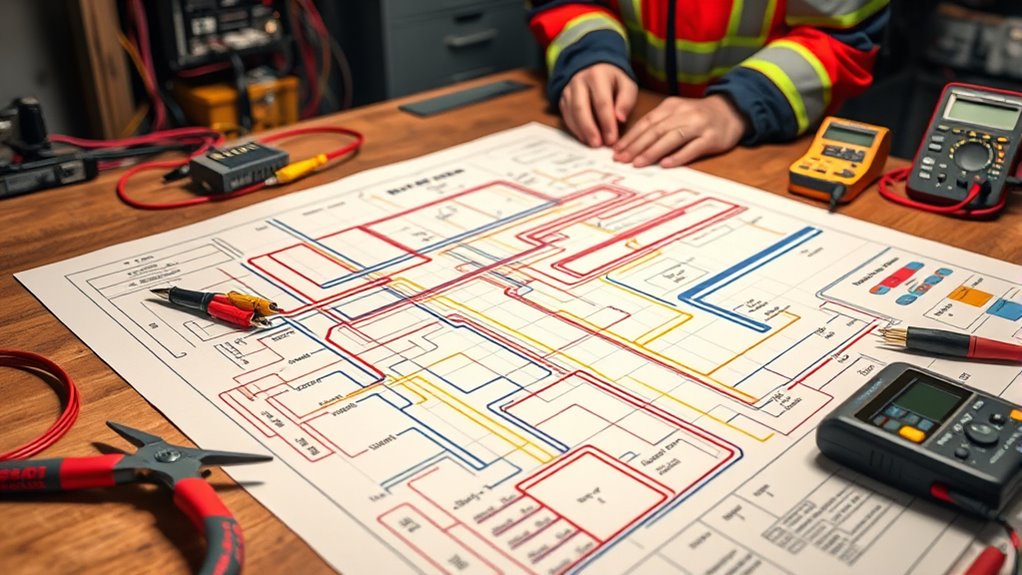
When wiring your backup system, you need to guarantee cables are properly sized to handle the generator’s load and meet NEC standards. Grounding and grounding connections must be correctly implemented to prevent shock hazards and ensure safety. Additionally, clearly labeling all circuits and wiring helps with maintenance and ensures compliance with safety codes. Properly identifying bad lemon juice can also serve as a reference for understanding how to detect issues in electrical components and prevent potential hazards.
Proper Cable Sizing
Proper cable sizing is essential for ensuring safety, efficiency, and reliability in backup power systems. You must calculate the expected current load by dividing wattage by voltage, then size cables for at least 125% of that current to account for continuous loads and surges. Use NEC tables or ampacity charts to select the appropriate wire gauge that can carry the calculated amperage safely. For longer cable runs, increase wire size to minimize voltage drop and maintain performance, especially in high-current DC systems. Copper cables are preferred for their superior conductivity, and insulation must match environmental conditions, including UV resistance for outdoor setups. Always follow electrical codes, provide secure routing, and use rated overcurrent protection to prevent overheating and ensure safe, reliable operation. Additionally, understanding industry trends can help in selecting the most efficient and durable components for your system.
Grounding and Labeling
Have you guaranteed that your backup power system is properly grounded and clearly labeled? Proper grounding ensures a safe, effective fault current path, preventing electrical hazards. Make sure generator grounding complies with NEC Sections 250.35 and 250.30(A), with a dedicated grounding electrode bonded to the equipment grounding conductor and connected to the utility system. Use appropriate bonding jumpers based on their location relative to overcurrent devices. Avoid bonding neutrals to ground at both the generator and service to prevent neutral current issues. Clearly label all grounding conductors, bonding jumpers, and neutral points to prevent wiring errors and facilitate maintenance. Signage and wiring identification are essential for quick recognition and troubleshooting during emergencies. Additionally, understanding the importance of data integrity in system monitoring can help ensure your backup power setup remains reliable over time. Maintaining proper grounding practices is vital for system safety, especially during fault conditions.
Integrating Backup Power Components
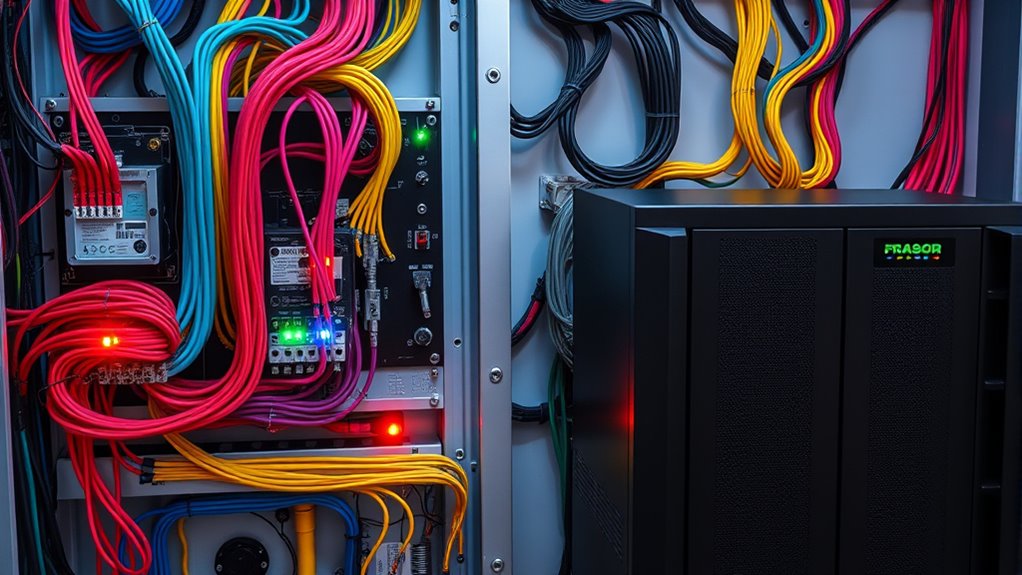
When integrating backup power components, you need to carefully select the right power sources and guarantee safe wiring practices. Properly connecting batteries, inverters, and controllers is essential to maintain system reliability and safety. Taking these steps helps create a seamless and effective backup power setup. Additionally, understanding regional resources and tools, such as local electricians or technical support, can facilitate a smoother installation process. Consulting with Volkswagen Tuning experts can also provide valuable insights into handling complex electrical modifications safely.
Selecting Power Sources
Selecting the right backup power sources is vital for ensuring continuous operation during outages, and it involves evaluating multiple options to meet your system’s specific needs. Start by assessing your load requirements, including total and critical loads, to determine appropriate generator capacity and UPS sizing. Consider your runtime needs; longer outages require larger batteries or fuel supplies. Response time is essential—UPS provides immediate power, while generators need time to start, so bridging solutions are necessary. Fuel type and availability, such as diesel, gas, or renewable sources like solar, influence operational logistics. Also, factor in maintenance costs and system lifespan. Additionally, understanding the benefits of raw food can help you appreciate the importance of proper nutrition in supporting system operations, including the health of backup personnel or systems. Incorporating organic farming methods can ensure the sustainability of your energy resources and reduce environmental impact. When choosing backup power, it’s also wise to consider system durability to ensure long-term reliability under various conditions. Ensuring proper circuit mapping during installation can prevent future malfunctions and facilitate easier maintenance. Combining these elements helps you choose reliable, efficient backup sources tailored to your site, ensuring seamless power during disruptions.
Ensuring Safe Wiring
Proper wiring integration is essential to ensuring your backup power system operates safely and reliably. You must never connect your generator directly to your home’s wiring through wall outlets, as this backfeeding creates electrocution and fire risks. Instead, install a double-pole, double-throw transfer switch to isolate your circuits safely, complying with electrical codes. Ensure the switch is used only when no loads are connected to prevent damage. Use properly rated, grounded extension cords that match your appliances’ wattage, and inspect them regularly for damage. Deploy GFCI protection on generator connections to prevent shocks. Always follow manufacturer instructions and local electrical regulations. When in doubt, hire a qualified professional to handle installation, guaranteeing safety and code compliance at every step.
Frequently Asked Questions
How Do I Determine the Total Backup Power Capacity Needed?
To determine your total backup power capacity, start by listing all essential appliances and their wattages. Estimate how long you’ll need each during an outage, then multiply wattage by hours to find watt-hours. Add these together for a total watt-hour requirement, and convert that to kilowatt-hours. This helps you choose a battery or generator that can supply enough energy for your critical needs during an outage.
What Are the Best Components for Seamless Power Transfer?
Think of your backup system as a well-choreographed dance. The best components include automatic transfer switches (ATS) for quick, hands-free switching, backup generators to keep the rhythm going, and uninterruptible power supplies (UPS) for sensitive gear. Static transfer switches (STS) add extra speed, while bypass isolation switches guarantee reliability. These elements work together seamlessly, ensuring your critical systems stay in step, no matter what surprises strike.
How Can I Prioritize Loads for Limited Backup Capacity?
You should start by categorizing your loads into critical, essential, and non-essential groups. Prioritize critical safety devices like medical equipment and smoke detectors first. Next, focus on essential household needs such as refrigeration and water pumps. Avoid overloading by calculating total wattage, including startup surges. Use transfer switches or automatic load shedding devices to manage limited capacity, and regularly review your load priorities to adapt to changing household needs.
What Safety Standards Apply to Backup Circuit Wiring?
Did you know that NFPA 110 and NEC standards are mandatory for backup circuit wiring? You must guarantee emergency power wiring is completely separated from normal circuits to prevent failure, and use approved transfer switches and protective devices. Regular inspections, proper insulation, and documentation are key. Always get your wiring approved by local authorities having jurisdiction (AHJ) to meet safety requirements and maintain system reliability.
How Do I Integrate Renewable Energy Sources With Backup Systems?
You can integrate renewable energy sources by connecting solar panels and wind turbines to your backup system through an inverter or energy management controller. These devices synchronize power flow, prioritize essential loads, and optimize energy use. Guarantee compatibility between components, use standardized communication protocols, and consider environmental conditions. This setup allows renewable sources to recharge batteries and supply your home during outages, increasing independence and reducing reliance on the grid.
Conclusion
Now that you’ve mapped out your essential circuits, it’s almost funny how much peace of mind you gain—until the next storm hits. Ironically, all that planning might just be what keeps you calm when the power’s out. So, enjoy your backup system, knowing you’ve prepared for the worst, even if it’s just so you can binge your favorite shows without interruption. After all, who knew that a little wiring could bring so much comfort?

